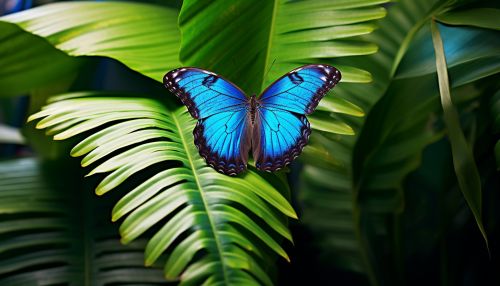Morpho Butterfly
Morphology and Appearance
The Morpho butterfly, belonging to the genus 'Morpho', is a large group of Neotropical butterflies. This genus includes over 29 accepted species and 147 accepted subspecies, found mostly in South America, Mexico, and Central AmericaCentral America. Morphos range in wingspan from the 7.5 cm (3.0 in) M. rhodopteron to the imposing 20 cm (7.9 in) sunset morpho, M. hecuba. The name "morpho" meaning "changed" or "modified" is also associated with these butterflies due to the numerous morphs they presentMorph.


The most striking aspect of the Morpho butterfly's appearance is their iridescent wings. The vivid color is a result of microscopic, diamond-shaped scales on the top of their wings, which reflect lightLight. The scales are so small that they interfere with the wavelength of light, sometimes causing a phenomenon called structural coloration. This is different from pigmentation, where the color is derived from pigments that absorb certain wavelengths of light and reflect othersStructural coloration.
Behavior and Life Cycle
Morpho butterflies exhibit many interesting behaviors. They are diurnal, meaning they are active during the day, and they have a unique flying pattern that helps them avoid predatorsPredation. The contrasting bright blue and dull brown colors of their wings create a flashing effect when they fly, which confuses potential predators.
The life cycle of a Morpho butterfly begins with the female laying eggs. The eggs are laid on the underside of leaves and are pale green in color. After about 9 days, the eggs hatch into caterpillarsCaterpillar. The caterpillars are red-brown with patches of bright green, and they have prickly hairs that deter predators.
After a period of intense feeding and growth, the caterpillar forms a chrysalis or pupaPupa, during which it undergoes metamorphosis into a butterfly. The adult butterfly emerges from the chrysalis after about 20 days. The entire life cycle of the Morpho butterfly, from egg to adult, takes about 115 days.
Habitat and Distribution
Morpho butterflies are primarily found in the tropical rainforests of South America and Central America. They can also be found in Mexico and the Caribbean islands. They prefer humid, tropical environments and are usually found near water bodies, such as rivers and streams.
Morpho butterflies are not typically found at high altitudes or in dry environments. They are most commonly found at elevations between sea level and 1,400 meters, but some species have been found at elevations up to 2,500 meters.
Conservation Status and Threats
The conservation status of Morpho butterflies varies by species. Some species are common and not considered threatened, while others are rare and considered endangered. The primary threats to Morpho butterflies are habitat loss due to deforestation and the illegal butterfly trade.
Morpho butterflies are highly sought after by collectors due to their large size and striking coloration. This has led to over-collection in some areas, which has had a negative impact on Morpho butterfly populations.
